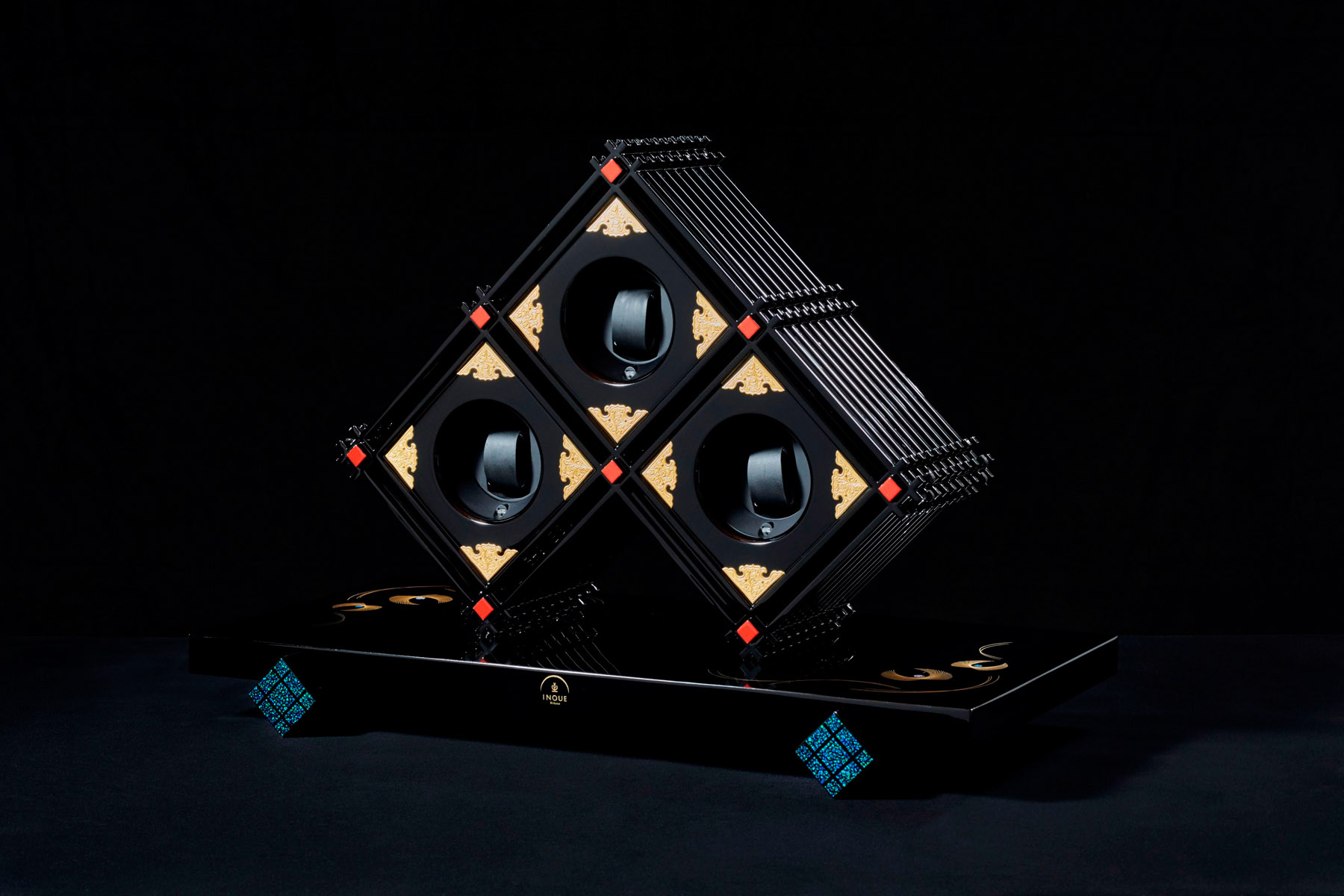HAFU Watch Case (Winder)

A winder case to complement and display your wrist watches. The frame for HAFU is made using the Japanese kumiko technique. Kumiko is a traditional Japanese woodworking technique that involves combining wood without the use of nails. It is stunningly delicate and beautiful.
Above the pedestal, both vertical and horizontal placement positions can be chosen.* The HAFU winder case is specially designed to contain the famous and reliable SWISS Kubik watch winders.
| Title | HAFU Watch Case (Winder) |
|---|---|
| Date | 2015.10 |
| Theme | Watch Winder Case |
| Techniques | Woodworking, high-gloss, natural lacquer finish, gold maki-e, Kyoto opal saikiko mother-of-pearl, press metal fittings, matte gold gilding |
| Material | Hiba wood, veneer board, lacquer, cashew, gold powder, Kyoto opal, press metal fittings |
| Size | Type3- Width:660mm; height:462mm; depth:354mm Type1- Width:278mm; height:298mm; depth:181mm |
| Client | Internally developed |
| Design | GreenValley Co., Ltd. |
| Photography | Keisuke Ono |
Integrated traditional materials and techniques
The frame is constructed using the kumiko technique which is also used in building Buddhist altars.
The maki-e applied to the pedestal uses a new lacquer technique called “saikiko.” Fine “Kyoto opals” are attached using lacquer and then polished while embedded in the lacquer. Kyoto opals are artificial opals developed by KYOCERA that change color depending on what angle they are viewed from.
Woodworking
Working with unfinished wood is an important initial process for creating the foundation or frame of a product.
Woodworking at INOUE is based on the exacting quality found in the traditional arts that have been cultivated by the production of Buddhist altars in the castle town of Hikone since the Edo Period (1603-1868 CE). Craftsmen produced these altars by hand and without nails, demanding uncompromising quality in the careful selection of the best materials for use in mortise and tenon construction. These altars are durable enough to be handed down through many generations. Furthermore, we have connections with woodworking shops in other areas that specialize in mass production, allowing us to select the appropriate methods of woodworking for any project.Lacquering
Lacquer is Japan’s exceptionally beautiful and high-quality traditional method of finishing. It is one of the most protective coatings in existence but can be very difficult to handle. Applying lacquer evenly requires the touch of a skillful craftsman from the first coat. The lacquer must be applied in many coats, from the first coat to the final finish, and the painting and polishing processes must be repeated many times over.
A high-gloss lacquer finish, considered the highest level of lacquer, involves the painted lacquer being polished flat, after which raw lacquer is repeatedly rubbed into the surface and polished to bring out a deep luster that is nearly mirror-like.
Based on our extensive knowledge of producing Buddhist altars, INOUE is able to offer the appropriate lacquering methods and craftsmen capable of implementing them, from a black, high-gloss lacquer finishes to a broad range of other coatings and lacquer colors.Maki-e
Maki-e is an artistic lacquer technique that involves drawing pictures or patterns using lacquer and then sprinkling them with gold dust or other fine powders. Maki-e originates in Japan and is one of the unique traditional techniques developed here. Maki-e includes many subsidiary techniques, such as hiramakie, takamakie, and togidashimakie. Furthermore, maki-e includes a wide variety of different end products, such as the expression of depth through different types or sizes of gold powder and the application of a variety of processing techniques.
At INOUE, we have built a network of maki-e craftsmen with a wide range of skills, allowing us to provide the skills needed for any project, from projects demanding the utmost quality to those needing to fit into a tight budget.Decorative fixtures (kazarikanagu)
While various types of metal fixtures are used in the arts, metalwork that is highly decorative in nature is called kazarikanagu. Metals such as brass or copper are used to fit the objectives and location of the fixture and various techniques are employed to shape the fixture, such as zibori to give the fixture a three-dimensional feel, kebori to engrave the fixture with fine lines and details, and sukashibori to create openings and provide a sense of depth. Other fixtures can also be produced through more cost-effective methods like metal pressing, electric casting, and etching.
We also provide the optimal techniques and decorative methods for adding finishes to kazarikanagu, such as gold plating, nickel plating or some other technique or combination thereof.Finishes (cashew, urethane, etc.)
At INOUE, the quality of our finishes is consistently and carefully scrutinized with a watchful eye. From sophisticated traditional techniques such as base coats of natural lacquer to cashew finishes made with the natural resin of the cashew tree, also a member of the lacquer family, to urethane finishes made with synthetic resins, we provide a wide variety of finishing techniques.
Given our extensive network of craftsmen with unparalleled technical skill, we can fulfill requests for finishes of nearly any kind.Kumiko
Kumiko is a stunningly delicate and beautiful method of wood construction that involves assembling wood without the use of nails. It is used for opening and closing components in Japanese construction, such as sliding doors, windows, and so on. Recently, it has come to be used in hotels and other retail locations that wish to create a modern, Japanese-inspired feeling. This has resulted in the development of many novel kumiko patterns. Finishes can be applied to kumiko and it can also be coated in gold leaf.
Gilding
Gilding is a surface processing technique that involves coating a target object, either metal or a non-metal such as plastic, with another metal. In the case of Buddhist altars, brass and copper surfaces are often gilded with gold or silver.